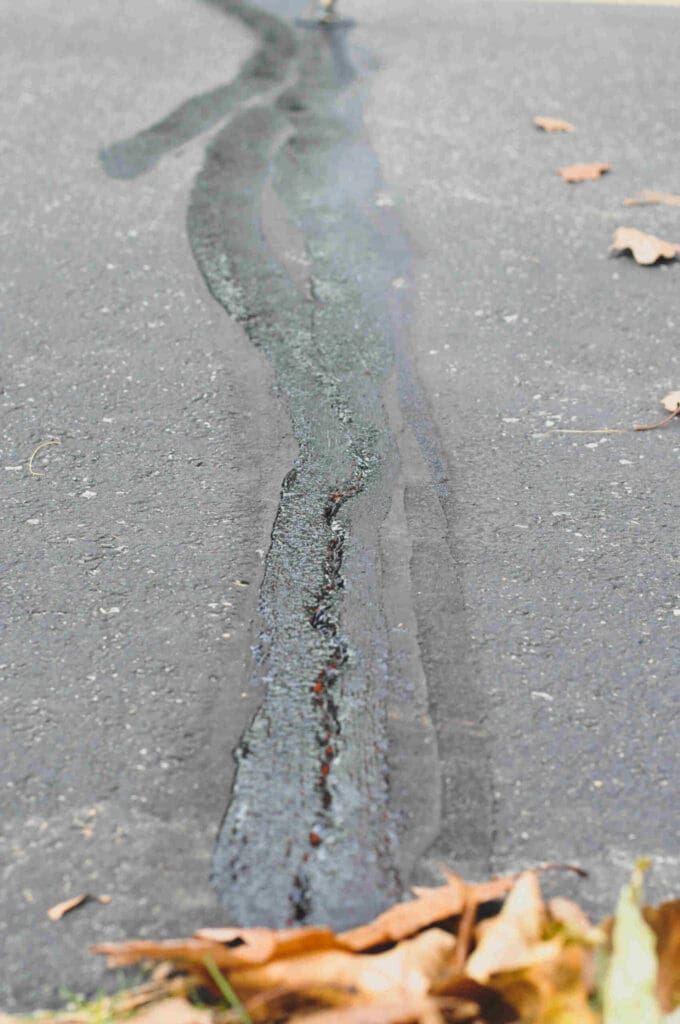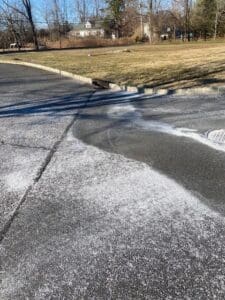Pavement cracks. It happens and it can’t be avoided. You can, however, avoid costly repairs and premature pavement deterioration by fixing cracks and other minor problems as they occur. By now you probably know the basics, but here is a quick overview!
Mother Nature is quite powerful; the extreme polarities of weather take their toll on all pavement. Water is one of the biggest direct factors in pavement deterioration. When water gets into the pavement subgrade, during winter months or other extremely cold periods, it freezes, expands and causes pavement to crack. When left unrepaired, water also causes the subgrade base to become unstable and prematurely deteriorate beyond repair.
So how does water get inside pavement in the first place? Overall deterioration due to road salts, heavy trucks, oil spots and sunlight are major factors. While water will directly cause cracks, the other factors are what allow water to penetrate through the surface layer in the first place. Sunlight dries out the tar in pavement, allowing small areas for water to seep through. Other forms of damage allow water to get in and cause damage. See how this all works? This is why routine crack filling and sealcoating of pavement keeps it in the best possible condition.
Let’s answer some of the most common questions asked about pavement cracks:
- When should pavement be crack filled? Crack filling should be done throughout the life of your pavement and at least once per year to keep your pavement in its best possible condition.
- What time of year should a parking lot or other pavement be crack filled? Crack filling season begins in April and ends in November. Crack filling can be completed in the winter months as long as it is dry. It is best to crack fill going into the winter months when the cracks in asphalt are as wide as possible. In the colder months cracks expand and in the summer months, cracks contract.
- How often should pavement be crack filled? Since this is part of routine maintenance, it can be done as often as needed but should ideally be done at least once per year.
- Can all types of cracks be filled? No. Only straight line cracks should be filled. Alligator cracks cannot be filled.
- Why can’t alligator cracks be filled? When alligator crack areas appear in a parking lot it means that water has penetrated the subgrade layer and that pavement can no longer support the weight of the traffic. It’s a sign of extreme pavement deterioration that requires complete pavement reconstruction to fix.
- How long does it take the crack filling material to dry? The crack filling material is applied at 300° F but cools to the touch in minutes. Black silica sand is broadcasted over fresh crack filler to prevent tracking.
- Will the crack filling material track into my buildings? It can if it is walked on prior to drying. We use black silica sand over the fresh crack filler to help prevent tracking, but any pavement area being repaired should be made off-limits before any repair work is started. During hot months crack filler softens. The black silica sand will also help at this stage to prevent tracking.
- Will sealcoat material stick to crack sealing material? Yes, it will. The two materials will bond but since the crack sealing material is designed to expand and contract through a wide temperature range, sealcoat can chip away from the crack sealant. There is a color difference between the two materials, so you can tell if a crack filled area needs to have another layer of sealcoat applied.
- We had our pavement crack filled and some of the cracks re-opened? This happens due to the freeze-thaw cycles in winter when greater expansion and contraction of pavement is occurring. Cracks may re-open due to excessive expansion and contraction. The filler is designed to adjust to moderate temperature fluctuations, but it will not always work during extreme weather conditions. This is why crack filling is a yearly maintenance procedure.
- How is crack filler applied and how does it work? Crack filler is applied hot (about 300° F) and is squeegeed tightly into crack. When crack filler cools off it expands. It’s designed to be flexible and moves with changes in temperature as pavement expands and contracts.
- Can pavement that has cracks be resurfaced or will it require complete reconstruction? Linear cracks in pavement are fine for resurfacing and do not require complete subgrade reconstruction. We use a paving fabric and sealant under the new asphalt overlay which keeps cracks from causing any problems. If pavement has alligator cracks, it will need to be completely reconstructed.
- Does sealcoat hide cracks and crack filler, making pavement look like new? No, it does not. You will see crack filler through sealcoat, as the crack filler is designed to expand and contract with temperature changes. Pavement takes on a dark, vibrant color after sealcoating, but you will still see repaired crack areas through the sealcoat.
- What is the best thing I can do to prevent cracks in my pavement? Two things: commit to yearly pavement inspection and maintenance to fix minor cracks and problems before they turn into bigger problems. Crack filling and sealcoating is the best way to prevent more cracks from forming in pavement. Second, be diligent about inspecting your pavement so you find small cracks before they turn into bigger ones.
Have any other questions? Feel free to contact us directly. Happy crack exploring!





